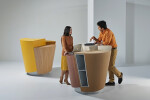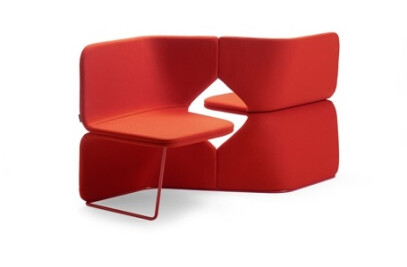The StandTable responds to these conditions by offering action stations that simultaneously operate as communication tools for both digital and personal interaction, whilst all the while encouraging variation in stance.
Designed to encourage user flexibility and to generate dynamic interactions within the office environment, the StandTable stations divide the traditional circular table into three parts and create plateaus of different heights, allowing the user to work in various positions. A place to work at, on, behind, around, the StandTable embodies flexibility in a user-generated way.
Ben van Berkel: “With the StandTable you can either work alone, or with a small group of people. Clustering a number of stations can also enable short term project based work within larger teams, where the stations can easily be reconfigured when desired, generating interaction, ease of movement and highly flexible working methods.”
In the StandTable station the three surfaces of different heights (90cm, 100cm and 110cm) stimulate the users to work in different positions and to fully occupy the circular space around the station. Thus the passive comfort and spatial restriction of traditional office furniture is replaced by active, healthy comfort and increased spatial freedom. The individual sections can also be manufactured at customised heights.
As today’s work stations increasingly become smaller due to digitalisation and this trend is predicted to continue in the future, both the compact size and the circular shape of the StandTable station substantially increases spatial efficiency, while stimulating healthy working practices and interactive knowledge exchange.

























